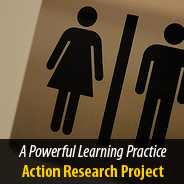Gender plays a significant role in shaping learning. However, educators and students are often unaware of gender biases that impact boys and girls in school. Based on discussions that faculty and students have had, we have decided to explore the role that gender bias has in our teaching and learning, in our interfacing with Web 2.0 tools, and in our overall school climate. Drawing on 21st century learning practices, we have decided to gather student, faculty, and administrator data to determine the extent of these biases, raise awareness of gender bias and the need for gender equity, and take steps to educate faculty, students and administrators in implementing strategies to promote gender equity in the classroom and the school culture.
Our research project is directed at “taking the pulse” of gender dynamics at North Shore Country Day School. We want to excavate our conscious and subconscious assumptions about gender and analyze the various ways in which they steer our students’, our administrators’, and our interactions with peers, superiors, and subordinates. We are interested in collecting and assessing not only empirical evidence about gender’s pervasive influence on personal relations at North Shore Country Day School, i.e., student, faculty, and administrator responses to online climate surveys and FlipCam documentation of classroom and extracurricular interactions. We are also interested in collecting and assessing Web 2.0 personal narratives that testify to particular individuals’ phenomenological experiences of inhabiting a gendered world and community, e.g., blog and Ning posts, Tweeted messages, Voicethreads and Podcasts. To monitor our success in making a shift in assumptions and how they play out in our classrooms and co-curriculars, we will distribute and analyze the climate surveys every two years to look for change and continue to monitor academic and co-curricular data over time.
- Gather NSCDS statistics about overall school success and standardized testing.
- Analyze NSCDS statistics about overall student success and standardized testing through the lens of gender. Note significant statistical variation among genders.
- Collect data that demonstrates how gender roles play out in the school community such as: class leaders; student council representatives; club leaders; graduation speaker
- Distribute online climate survey to students during advisory period.
- Analyze climate survey responses through the lens of gender. Note significant statistical variations among genders.
- Have students in English and language classes create Web 2.0 personal narratives that testify to their phenomenological experiences of inhabiting a gendered world and community.
- Have faculty and administrators during an in-service day create Web 2.0 personal narratives that testify to their phenomenological experiences of inhabiting a gendered world and community.
- Analyze Web 2.0 personal narratives and tease out common threads. Note significant variations in contents and forms of Web 2.0 personal narratives.
- On Diversity Day, showcase a range of student, faculty, and administrator Web 2.0 personal narratives at an all-school gathering. Have follow-up conversations at community gathering or in advisories.
- Create various forums for student discussions about gender dynamics at NSCDS – Create an NSCDS blog about gender relations.
- Create two focus groups by gender of students across grades to discuss key aspects generated by surveys and data and film them.
- Conduct classroom observations (in person and using Flip cameras) of student and teacher behavior and interaction and record observations on a checklist. Discuss them using the Critical Friends Model.
- Use asynchronous and synchronous Web 2.0 tools (ning, google sites, or a blog-perhaps linked to the NSCDS Dublin group blog) to create a space where faculty can share articles, post questions, share ideas and observations regarding gender bias and gender equity and the impact they have on learning, academic success, self-esteem, opportunities and career choices.
- Create various forums for administrator discussions about gender dynamics at NSCDS. Create an NSCDS blog about gender relations.
- Distribute and analyze the climate surveys every two years to look for change.
- Continue to monitor academic and co-curricular data over time
North Shore Country Day has recently hired a Director of Diversity who will be analyzing the data from the faculty and student surveys over the summer. Because climate is not just numbers, it is also spirit, we will analyze data along with the Web 2.0 personal narratives gathered from faculty and staff. Using this information, we will project the next steps to take. Our ultimate goal is creating a successful community of educators and learners.
Survey for faculty, general results
Survey for students – climate Blog
Flipcam documentation
Podcasts
Observation checklist


